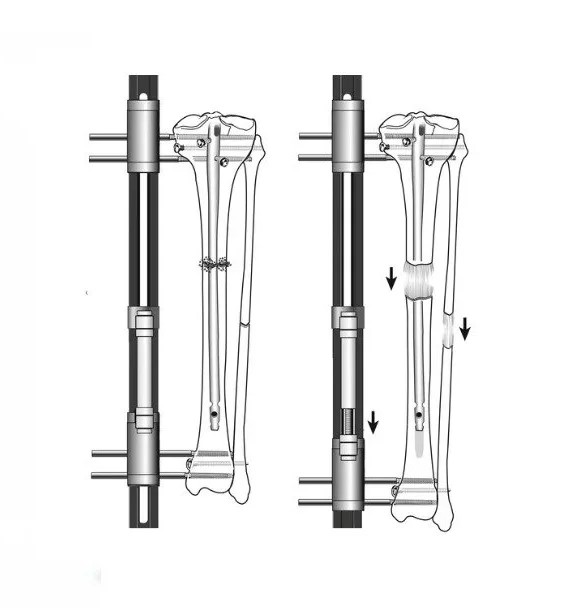 We have compiled all the questions you might have about the LON method, a limb lengthening surgery technique chosen by many patients due to its affordability. First and foremost, it’s crucial for individuals considering limb lengthening surgery to be well-informed about the process and the techniques involved. The recovery period can be relatively long and challenging, so it’s important for patients to be aware and prepared. After the surgery, it’s essential for patients to consistently follow through with their physiotherapy routines correctly, pay attention to wound and dressing care, and understand that they won’t be able to resume their daily lives as before for a while. For more detailed information about the process, you can visit our YouTube page and for any additional questions, feel free to contact our patient representatives directly.
We have compiled all the questions you might have about the LON method, a limb lengthening surgery technique chosen by many patients due to its affordability. First and foremost, it’s crucial for individuals considering limb lengthening surgery to be well-informed about the process and the techniques involved. The recovery period can be relatively long and challenging, so it’s important for patients to be aware and prepared. After the surgery, it’s essential for patients to consistently follow through with their physiotherapy routines correctly, pay attention to wound and dressing care, and understand that they won’t be able to resume their daily lives as before for a while. For more detailed information about the process, you can visit our YouTube page and for any additional questions, feel free to contact our patient representatives directly.
- Following limb lengthening surgery utilizing the LON technique, how long is a patient unable to walk?
Patients who have undergone surgery with the LON technique are assisted by nurses to stand up for bathroom needs starting the day after the surgery. (Attempting to do so on their own within the first two days is considered risky.) - What is the duration of hospitalization for patients following their surgery?
Patients are typically hospitalized for a duration of 5 days post-surgery. Throughout this time, specialized medical staff follow the patient’s overall health and initiate the physiotherapy regimen. - When is physiotherapy begun?
Physical therapy begins on the second day of the hospital stay. During the first week, physiotherapy sessions are scheduled every other day, and once the patient moves to the hotel (for those who choose to stay in our contracted hotel), they continue daily except on weekends. However, depending on the extent of lengthening, some patients may require additional physiotherapy, and if the doctor considers it necessary, Saturday sessions can also be arranged. - How do patients meet their toilet needs after surgery?
For the first two days after surgery, patients utilize a catheter, although its usage can be extended up to five days upon the patient’s request. Throughout this period, physiotherapy sessions begin on the second day to assist patients in adapting to the bathroom routine. Physiotherapists provide the necessary guidance during this process to help patients discontinue catheter use and regain regular toilet habits. - How can patients take a shower after surgery?
During leg-lengthening surgeries using the LON method, an external fixator is applied to the leg. Consequently, it is of utmost importance to prevent the wounded area from being exposed to water during the post-operative extension phase in order to reduce the risk of infection. Patients typically follow a practice of getting only their waist and upper body wet during their cleaning routines, or they opt to use specialized bags toprotect the fixed area. These precautions are designed to assist patients in comfortably managing the post-operative period while protecting their health. - Does using a fixator cause infections in the wounded area?
The use of a fixator does not inherently pose a risk of infection. When post-operative dressings are promptly applied, and the fixed area remains dry, the risk of infection is considerably low. Medical teams play a crucial role in conducting all required assessments to ensure a healthy recovery process. - How do patients manage to sleep at night while wearing fixator?
One of the most common inquiries from patients considering surgery using the LON method pertains to their sleep habits. Due to the external leg fixator, patients undergoing this procedure are required to sleep on their backs during the night. To aid in this adjustment, some patients may use pillows to restrict their leg movements while sleeping. Typically, once the fixator is removed, patients can return to their usual sleep patterns within 3-4 weeks, depending on the progress of their wound healing.
- How do patients perform leg extension using the LON method?
With the LON method, patients extend their legs manually on a daily basis, which is not a complex procedure. Using the hex key provided on the outside of the fixator, patients perform 1mm extensions four times a day, spaced approximately every 6 hours. - When is the fixator taken off?
The removal of the fixator varies depending on the patient’s overall health condition, typically occurring between 2.5 to 3 months after the first placement. Following the removal of the device, patients will continue to walk with support for an additional 2-3 months due to the fact that their legs have not completely healed at that point. - When do patients go back to their home countries?
A crucial aspect of the LON method is that patients return to their home countries once the fixator is removed, ensuring a smooth recovery process. Since the fixator removal process spans 3 months, it is imperative for patients to remain in close proximity to the hospital and their doctor during this period. - How long should patients continue their physiotherapy and x-ray sessions after returning to their home countries?
After returning home, we recommend that patients continue their physical therapy with a local physiotherapist for a period of 1-3 months. It is also crucial to incorporate daily exercises, such as using treadmills, into the recovery process (although patients should consult their doctor before starting any personal exercises).As for x-rays, it is essential for patients to have them every 15 days during the lengthening phase, followed by intervals of every 5-6 weeks after the lengthening phase. Subsequently, the frequency of x-rays should be determined based on the doctor’s recommendations. - When can patients begin walking without assistance?
Patients who opt for the LON method can typically start walking independently after approximately 5-6 months. During this period, exercises and ongoing doctor supervision play a crucial role. - Is it feasible to resume sports activities after transitioning to unassisted walking?
Patients can engage in upper body workouts starting from the first week after surgery. Depending on their overall health, patients can typically begin walking without assistance approximately 5-6 months after the operation. Nevertheless, the optimal time to reintroduce sports activities is between 9-12 months post-surgery. Starting sports too early or engaging in overly intense activities can potentially harm the legs.
- When can patients start driving?
Patients may gradually resume driving once they have completed the leg lengthening process and have received approval during their medical check-ups. However, it’s essential to note that there isn’t a fixed timeframe for this, as the patient’s bone health remains the primary consideration.

